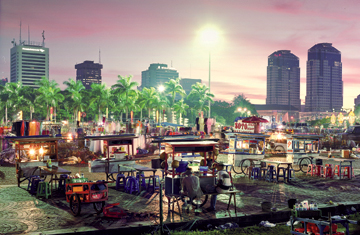
Dawn breaks over Jakarta's Merdeka Square — the center of Pram's brooding anthology
Behind Jakarta's crisp neoclassical National Museum is the cluttered neighborhood of Kebon Jahé Kober, named for ginger farms that once occupied the area, and for a colonial cemetery some blocks away. There, in a wrinkle of ashen alleyways, the 24-year-old Pramoedya Ananta Toer — Indonesia's most prominent writer, who died in 2006 before getting the Nobel he deserved — lived with his new wife and her family after being released from prison in December 1949, just weeks before Dutch authorities recognized Indonesia's independence. After 2½ years in jail (for being caught with anti-Dutch paraphernalia), you'd think anything would be a welcome change. But Pram, as he's popularly known, found the place foul and unlivable. The gutters were full of human ordure and the air was stale from the smell of "cheap death," he recalled in the story "My Kampung," from his early collection Tales from Djakarta. Its mordant stories revolve around what is now Jakarta's central Merdeka (Freedom) Square, and the streets close by.
Visitors today to the Indonesian capital might find Pram's take extreme. True, men and boys still relieve themselves in Kebon Jahé Kober's sewers. But the small neighborhood, in the middle of Jakarta's bustle, is an oasis of quiet lanes with socks drying on bamboo poles and friendly bakso (meatball) vendors sucking on spicy, crackling kretek. They'll smilingly guide you to the still standing, ramshackle house of its most famous onetime resident, at No. 8, Gang (Lane) III — although Pram didn't really do much to deserve local affection. Not only did he quickly tire of his first wife and move out, but in "My Kampung," he skewers his neighbors as dim-witted and superstitious. An ailing print setter, for one, concludes that his baby's death from tetanus has sated the Archangel Gabriel; therefore, he thinks, I must be safe from death's swift messenger. Two weeks later the print setter croaks, his pancreas corroded from lead poisoning. Dark, but hardly atypical of Tales from Djakarta, in which the characters suffer awful and lonely fates, ranging from sexual abuse to execution.
"Ketjapi," published in 1956 and the last of the 13 stories, is about a Sundanese debt collector who moves to Jakarta after his marriage fails, his only consolation the melancholic tones of the story's namesake instrument, his future "tattered and full of holes." It's an equally apt description of Indonesia, which had recently emerged a sovereign but brittle country after centuries of Dutch rule, Japanese occupation and four years of revolution. Reflected in each of Pram's protagonists from the fringe — illiterate wash maids, scabietic houseboys, night watchmen, guttersweeps — are the growing pains of a tentative new nation.
In "Stranded Fish," homeless, starving former freedom fighter Idulfitri wanders by lusty foreign-movie posters with "naked thighs" on Merdeka Square near the Presidential Palace and wonders, "Why aren't there any pictures showing how hunger twists and turns in my guts?" The rest of the story is a picture precisely of that, as Idulfitri engages in Godot-like banter with a fellow revolutionary turned rake while they scrounge for a meal. Eventually they sell a monitor-lizard-skin wallet to a hawker on South Gambir Street (now Jalan Medan Merdeka Selatan, home to banks and the U.S. embassy) for satay money. Before that, they doze in a corner of the square popular with "shadows of the night" like Aminah, a prostitute from the lurid tale "News from Kebajoran." She dies in a fit of delirium on a cold concrete bench nearby. How ironic, then, that a statue of Raden Kartini, the women's-rights advocate whose biographer Pram would later become, now stands in the square.
The prostitutes have since moved elsewhere, and as it was for the Dutch, who knew it as Koningsplein (King's Square), the area today is a place of easy leisure, of bucolic clumps of crape myrtle and mahogany trees, whose center is the Monumen Nasional — founding father Sukarno's heroic white obelisk. From its observatory deck, you'll see the Kali Besar, Jakarta' big canal dug during the city's prosperous days as a tropical spice-trading port, running north. South is Menteng, the early 20th century planned garden neighborhood where local elite, like the late Suharto's clan, reside. For them Jakarta again is a town of joy, booming with steel, glass and shining retail spaces. But Tales of Djakarta, in which the poor bathe in the canal's toxic "yellowish water" and Japanese officers fill Menteng's villas with comfort women, obstructs those pretty views. Though not void of hope, Jakarta for Pram was a town of tough and busy griefs. The bakso sellers in and around Merdeka Square might still agree.
